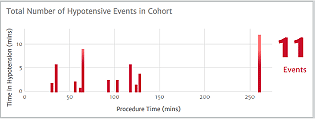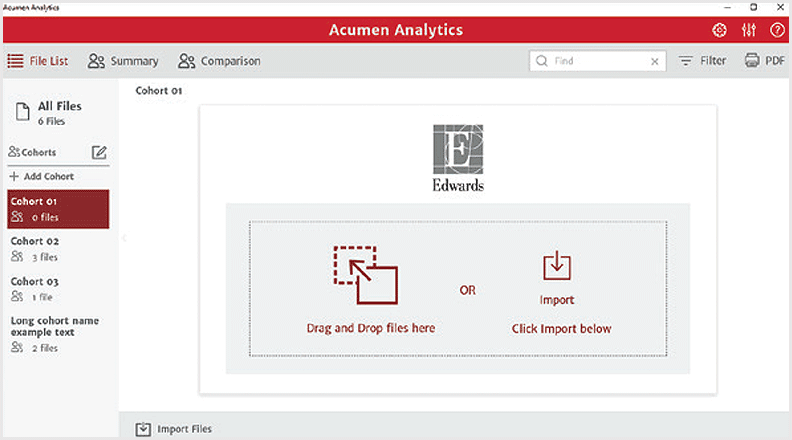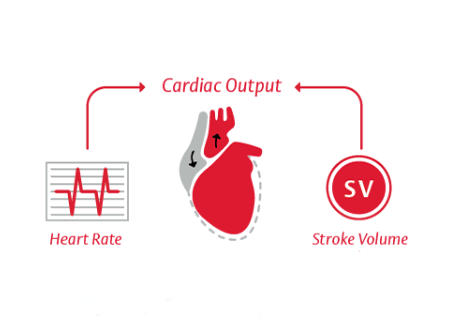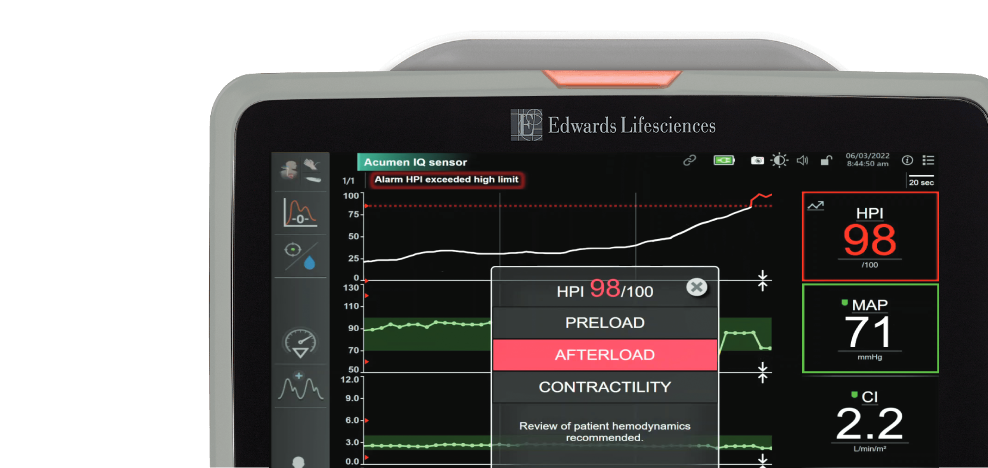
Acumen Analytics software


Acumen Analytics software offers you retrospective data analysis and hemodynamic insights into patient perfusion all on your personal computer.
Acumen Analytics software allows you to retrospectively view and analyze monitored hemodynamic parameters from HemoSphere advanced monitoring platform when used with Acumen IQ cuff, Acumen IQ sensor, ClearSight finger cuff, FloTrac sensor, ForeSight sensor, or TruWave disposable pressure transducer.
When using any of the blood pressure monitoring cuffs and sensors (Acumen IQ cuff, Acumen IQ sensor, ClearSight finger cuff, FloTrac sensor, or TruWave disposable pressure transducer), Acumen Analytics software allows you to highlight key events including:


Hypotension duration

Hypotension prevalence
Please note that not all sensors may be used with all monitoring platforms.
How Acumen Analytics software works

Analyze
Acumen Analytics software analyzes retrospective hemodynamic parameter data from HemoSphere advanced monitoring platform when used with an Acumen IQ cuff, Acumen IQ sensor, ClearSight finger cuff, FloTrac sensor, ForeSight sensor, or TruWave disposable pressure transducer.
Please note that not all sensors may be used with all monitoring platforms.

Transfer
Monitoring sessions can be downloaded from the HemoSphere advanced monitoring platform onto the Acumen Analytics software onto your desktop or laptop computer. The report includes demographics data that you can organize and analyze. Patient identifiers are omitted from the data.

Review
The Acumen Analytics software primary screen allows you to retrospectively analyze data within and between cohorts or on individual patients.
Key features of Acumen Analytics software

Customizable viewing pane
With a streamlined and customizable tile layout, the main viewing page organizes a list of all cases, cohort summaries, and cohort comparison for convenient overviews.

Hypotension statistics
This case summary list provides statistics on key hypotensive calculations such as average number of hypotensive events*, duration of each event, number of patients in a cohort that experienced hypotension.

Cohort comparison
The cohort comparison screen allows you to retrospectively compare data from two cohorts. Hypotension data includes duration of hypotension and mean arterial pressure (MAP) events. The customizable cohort summary screen displays a summary of the data collected for the chosen patient or patient group.

Trend parameters
At the core of Acumen Analytics software is advanced hemodynamic parameter data. You can review recorded data on a number of valuable pressure and flow parameters as well as tissue oxygen saturation from HemoSphere monitoring platform. See chart below for available parameters.
| Parameter** | Description |
| Hypotension Prediction Index (HPI) | Indicates the likelihood of a patient trending towards a hypotensive event* |
| Dynamic arterial elastance (Eadyn) | Ratio of pulse pressure variation (PPV) to stroke volume variation (SVV). It's an estimate of arterial elastance. |
| Systolic slope (dP/dt) | Maximum upslope of the arterial pressure waveform from a peripheral artery. It is the maximum rate of the arterial pressure rise during left ventricular contraction |
| Cardiac output (CO) | Volume of blood pumped by the heart measured in liters per minute |
| Cardiac index (CI) | Cardiac output relative to body surface area (BSA) |
| Systolic pressure (SYS) | Systolic blood pressure |
| Diastolic pressure (DIA) | Diastolic blood pressure |
| Mean arterial pressure (MAP) | Averaged systemic blood pressure over one cardiac cycle |
| Pulse rate (PR) | Number of ventricular contractions per minute |
| Stroke volume (SV) | Volume of blood pumped with each heart beat |
| Stroke volume index (SVI) | Stroke volume relative to body surface area (BSA) |
| Systemic vascular resistance (SVR) | The resistance that the left ventricle must overcome to eject stroke volume with each beat |
| Systemic vascular resistance index (SVRI) | SVR relative to body surface area |
| Stroke volume variation (SVV) | The percent difference between SVmin, max and mean |
| Central venous oximetry (ScvO2) | Venous oxygen saturation as measured in the superior vena cava |
| Mixed venous oximetry (SvO2) | Venous oxygen saturation as measured in the pulmonary artery |
| Tissue oxygen saturation (StO2) | A noninvasive continuous assessment of the balance between oxygen delivery and consumption through either cerebral or somatic tissue oximetry |
*A hypotensive event is defined as MAP <65 mmHg for a duration of at least one minute.
**Not all parameters are available with all sensors or all monitoring platforms
Risk of hypotension
Research findings have revealed strong associations between intraoperative hypotension (IOH) and elevated risk of both acute kidney injury (AKI) and myocardial injury after noncardiac surgery (MINS).1,2,3
Acumen HPI software is effective in detecting hemodynamic instability and substantially reducing the amount of intraoperative hypotension when used in surgical patients who require intraoperative hemodynamic monitoring during noncardiac surgery.

IOH is common1
88% of patients continuously monitored with an arterial line still experienced hypotension, defined as MAP <65 mmHg for at least 1 min.4

IOH has elevated risks
Prolonged exposures below mean arterial pressure (MAP) thresholds of 65 mmHg are associated with increased risk of mortality, myocardial injury and AKI after noncardiac surgery.1,5

IOH can be reduced
Acumen HPI software has demonstrated a reduction* in the duration of IOH by 57%.6
* Single arm, multicenter, prospective-to-historical control where patients received arterial line monitoring.
Physiology of perfusion

Adequate perfusion requires adequate arterial pressure and cardiac output (CO)

Cardiac Output (CO) = Stroke Volume x Heart Rate

Preload: the tension of myocardial fibers at the end of diastole, as a result of volume in the ventricle

Stroke Volume (SV): volume of blood pumped from the left ventricle per heartbeat
When managing volume, stroke volume variation (SVV) has been proven to be a highly sensitive, reliable, and specific indicator for preload responsiveness in loading conditions induced by mechanical ventilation.7-10
Compatible monitoring platform
HemoSphere advanced monitoring platform

The only modular hemodynamic monitoring platform to offer full-range cuff, sensor and catheter compatibility and first-of-its-kind predictive decision support software, HemoSphere advanced monitoring platform enables proactive, individualized patient management.


The EV1000 clinical platform

The EV1000 clinical platform from Edwards Lifesciences presents the physiologic status of the patient in an intuitive and meaningful way. The EV1000 clinical platform enables you to choose the parameters needed to monitor your patients and is compatible with a number of Edwards advanced hemodynamic monitoring solutions.
Acumen intelligent decision support suite

Acumen Hypotension Prediction Index (HPI) software
Acumen HPI software provides you with information regarding the likelihood of a patient trending toward a hypotensive event.*
A single arm, multicenter study demonstrated that Acumen HPI software reduced hypotension by 57% compared to a historical control where patients received arterial line monitoring. This predictive software was shown to detect hemodynamic instability and substantially reduced intraoperative hypotension when used in surgical patients who require hemodynamic monitoring during noncardiac surgery.
*A hypotensive event is defined as MAP <65 mmHg for a duration of at least one minute.

Acumen IQ cuff
The Acumen IQ cuff enables you to unlock the Acumen Hypotension Prediction Index (HPI) software for surgical patients, while delivering continuous blood pressure monitoring and advanced hemodynamic parameters noninvasively.

Acumen IQ sensor
The Acumen IQ sensor unlocks Acumen HPI software for surgical and nonsurgical patients. The Acumen IQ sensor automatically updates advanced parameters every 20 seconds, reflecting rapid physiological changes in moderate- to high-risk surgery and patients in the intensive care settings.

Acumen Analytics software
Acumen Analytics software enables you to retrospectively view and analyze hemodynamic parameters, including mean arterial pressure, providing you insights into the frequency, duration and prevalence of intraoperative hypotension in your practice.
System requirements:
- Minimum 32GB hard drive (minimum) with 3GB available disk space
- Memory: 8GB RAM minimum
- Compatible with Windows 7, 8 and 10 (32 & 64 bit)
- Supports excel files that contain data points in 20-second time intervals
References
- Salmasi, V., Maheshwari, K., Yang, G., Mascha, E.J., Singh, A., Sessler, D.I., & Kurz, A. (2017). Relationship between intraoperative hypotension defined by either reduction from baseline or absolute thresholds, and acute kidney injury and myocardial injury. Anesthesiology, 126(1), 47- 65.
- Sun, L.Y., Wijeysundera, D.N., Tait, G.A., & Beattie, W.S. (2015). Association of intraoperative hypotension with acute kidney injury after elective noncardiac surgery and myocardial injury. Anesthesiology, 123(3), 515-523.
- Walsh, M., Devereaux, P.J., Garg, A.X., Kurz, A., Turan, A., Rodseth, R.N., Cywinski, J., Thabane, L., & Sessler, D.I. (2013). Relationship between intraoperative mean arterial pressure and clinical outcomes after noncardiac surgery. Anesthesiology, 119(3), 507-515.
- Shah, N., Mentz, G., Kheterpal, S. The incidence of intraoperative hypotension in moderate to high risk patients undergoing non-cardiac surgery: A retrospective multicenter observational analysis. Journal of Clinical Anesthesia. 2020;66:1-12.
- Wesselink EM, et al. Intraoperative hypotension and the risk of postoperative adverse outcomes: a systematic review. Br J Anaesth. 2018;121(4):706-721. 42 studies’ noncardiac surgery patient number ranged from 40 to 152,445, with a median of 1,523 patients (inter-quartile range 261-17,739).
- U.S. Food and Drug Administration. 2021. K203224 510k Summary, Acumen Hypotension Prediction Index, viewed August 24, 2021.
- Berkenstadt, H., et al. (2001). Stroke volume variation as a predictor of fluid responsiveness in patients undergoing brain surgery. Anesthesia & Analgesia, 92, 984-9.
- McGee, W.T. (2009). A simple physiologic algorithm for managing hemodynamics using stroke volume and stroke volume variation: physiologic optimization program. Journal of Intensive Care Medicine, 24(6), 352-360.
- Peng, K., Li, J., Cheng, H., Ji, FH. (2014) Goal-directed fluid therapy based on stroke volume variations improves fluid management and gastrointestinal perfusion in patients undergoing major orthopedic surgery. Medical Principles and Practice, 23(5), 413-20.
- Li, C., Lin, F.Q., Fu, S. K., Chen, G. Q., Yang, X. H., Zhu, C. Y., Zhang, L. J., & Li, Q. (2013). Stroke volume variation for prediction of fluid responsiveness in patients undergoing gastrointestinal surgery. International Journal of Medical Sciences, 10(2), 148.
Important safety information
CAUTION: Federal (United States) law restricts this device to sale by or on the order of a physician.
See Instructions For Use (IFU) / Directions For Use (DFU) for full prescribing information, including indications, contraindications, warnings, precautions and adverse events.

